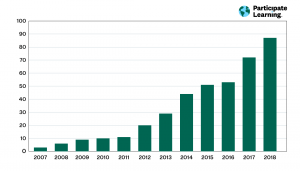Learning a new language is always a challenge, but it’s even more so for students in a new country where the native tongue is not their own. In those situations, students are not only trying to learn a second language but doing so in tandem with their regular academic studies. Learning a new language adds to the challenges for students who may also have to adapt to a new curriculum.
Dual language programs may provide the answer. They’re on the rise in the U.S., with over 2,000 programs now helping students as young as pre-kindergarten to learn a second language. They are one of the most efficient, effective, and rewarding ways to pick up a new tongue while maintaining their native one.

Dual language programs are also proving to be far more beneficial to English Language Learners (ELLs) than simply placing those students in English-speaking classrooms.
Greater English proficiency for English Language Learners
A recent study by the RAND Corporation found that ELLs in dual language programs are more likely to succeed academically in a number of key areas. In comparison to English learners who were not enrolled in dual language programs, these students were found to:
- Outperform their peers on state reading tests
- Be more likely to be classified as “English proficient” by grade 6
Build confidence and empower students
The integrated nature of dual language programs brings further benefits to ELLs in US classrooms. In contrast to English-only classes, these students are able to continue to use their native language in dual language immersion classrooms and also maintain their sense of identity and heritage. This can be a boost to student self-esteem and confidence.
In turn, this confidence helps to improve students’ communication skills, both in their new language and their native one. Through re-learning how to express themselves, they improve their ability to communicate clearly. The nature of dual language classes also ensures that students gain confidence in public speaking, regardless of which language they are using.
By combining confidence, self-esteem and a strong sense of identity, ELLs often feel empowered to take on leadership roles in the classroom. They become engaged and active participants in discussions. They also gain a sense of shared responsibility with their fellow students.
More effective than traditional language learning
Educators, administrators, parents, and students should not underestimate the power of dual language programs compared to traditional methods of learning a new language. These programs are vastly different from taking a specific class or receiving instruction in a small group or resource class to learn English.
When English Language Learners have an authentic opportunity to demonstrate their strengths and to shine in their school setting, they will truly grasp how capable they are and that their possibilities are endless. They are no longer in a situation where they are starting from behind; rather the classroom playing field is level for everyone. Students who experience success, no matter the language, are more motivated and interested in classroom performance
Summary
The benefits of mastering a second language are wide-reaching. Not only do ELLs become more easily immersed into a new culture via dual language programs, but they also tend to outperform their peers academically. They improve their communication skills in their native tongue and boost their future career prospects.
Successfully completing a dual language program may also act as a signal to colleges and universities as to the ELL’s ability and potential. It shows that they have become proficient in the English language and also excelled academically
To find out more about dual language programs and how they can benefit students and educators, read this blog post or explore Participate Learning’s resources for more information.




